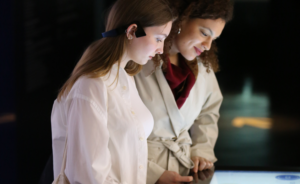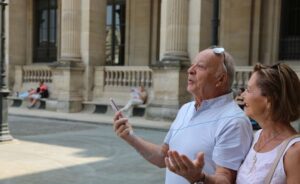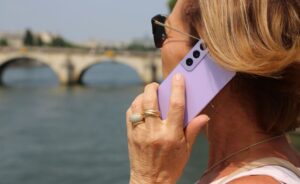Blog

Ies Audioguides Serving Inclusivity
Audio guides play an essential role in democratizing access to culture. By offering a flexible alternative to traditional guided tours, they enable personalization of the experience for each visitor, whether young or old, able-bodied or disabled. This personalization is all the more important for people with disabilities, for whom physical and sensory accessibility to cultural spaces remains a challenge. Sycomore-Vox is committed to making this technology accessible to all by developing specific audio guides and producing content adapted to the particular needs of each group of visitors.
Accessibility for visually impaired or blind people
For visually impaired or blind people, access to works of art, exhibitions and cultural sites may seem limited. Audio guides fill this gap. At Sycomore-Vox, the audio guides are designed with buttons that are easily identifiable thanks to pins on certain numbers, which allows users to find their way by touch. Additionally, tailored volume options and voice commands are integrated, making interaction easy without complex manual manipulation.
Voice commands represent a major advance for visually impaired or blind people, allowing them to interact with the audio guide independently. Virtual assistants can also be integrated to answer specific user questions, making the visit experience even more seamless and personalized.

In terms of content production, particular attention is paid to writing comments for these audiences. The descriptions are more detailed and include full audio descriptions of the works and spaces. These commentaries are written by specialists and are often longer than those intended for sighted people, in order to provide a complete sensory experience. The objective is to guide blind visitors so that they can mentally represent the works and spaces, while fully immersing themselves in the experience.
Accessibility for deaf or hard of hearing people
Deaf or hard of hearing people require specific solutions to access cultural content. Sycomore-Vox meets these needs with adapted audio guides. For people who are hard of hearing, the audio guides offer adjustable volume options and accompany each commentary with a text transcription. This allows users to access information both auditorily and visually.
For deaf people, access to information requires the use of large screens, such as those available on tablets or smartphones. The comments are offered in the form of videos in sign language, accompanied by subtitles and text transcriptions. These videos may also include animations, drawings or photos to enrich the visual experience. The contents are written in a clear and concise manner, avoiding technical or ambiguous terms which could complicate understanding.
The integration of audio guides with mobile applications also allows these options to be extended directly to users’ smartphones. This provides additional flexibility, allowing visitors to use their own device, often already configured to their specific needs.
Accessibility for people with reduced mobility
For people with reduced mobility, the accessibility of audio guides is not limited to the technical design of the devices, but also includes the physical and ergonomic design. Audio guides should be lightweight, portable and easy to use without requiring complex movements. This is particularly important for visitors in wheelchairs or with mobility difficulties.
In addition to the ergonomic design of audio guides, it is crucial that audio tours are designed to be easily accessible. This includes avoiding physical obstacles like stairs, narrow passages or uneven surfaces. Museums and other cultural sites should consider alternative routes to ensure that all visitors can fully enjoy the experience, regardless of their physical needs.

Accessibility for people with cognitive disabilities
People with cognitive disabilities may have difficulty understanding complex texts or abstract concepts. For these visitors, Sycomore-Vox offers content written in “Easy to Understand” (FAC), a communication method that makes information accessible to a wider audience.
Comments in FAC are written with simple and everyday vocabulary, using short and direct sentences. Each comment is clearly structured with headings and subheadings to guide the visitor through the information. Images, icons or pictograms can be integrated to help understand the texts. This approach facilitates understanding for people with intellectual disabilities, but also for other groups such as the elderly or non-native speakers.
The FAC is not only useful for people with cognitive disabilities, but also for any visitor who might feel overwhelmed by complex information. By making content more accessible, audio guides contribute to a more inclusive and satisfying visiting experience for everyone.
Towards even more accessibility: the future of audio guides
Continuing to improve the accessibility of audio guides requires the adoption of emerging technologies such as augmented reality (AR). AR allows visual information to be overlaid on the real environment, which can be extremely useful for people who are hearing or cognitively impaired. For example, interactive maps or sign language avatars can be used to guide visitors in a more engaging and interactive way.
In addition, the standardization of practices is essential to guarantee consistency in the proposed offer. Clear standards on device design, content accessibility and technology options to integrate can help standardize the user experience and ensure that all visitors, regardless of their disability, can access information in an appropriate manner. fair.
A continued commitment to a more inclusive culture
The accessibility of audio guides for people with disabilities is a crucial issue in making culture accessible to all. Through innovative technological solutions and an inclusive approach, it is possible to create enriching visitor experiences without exclusion. Sycomore-Vox, by embarking on this path, demonstrates that it is possible to combine technology and humanity to offer everyone the opportunity to discover the wonders of our cultural heritage. By continuing to innovate and adapt these tools, we can hope for a future where every visitor, whatever their condition, will have access to culture in all its richness.





